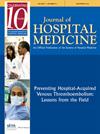Big brother or big opportunity? Utilization of EHR use metadata in the inpatient setting: A mixed methods study at 16 organizations
Abstract
Background
Clinician electronic actions within the electronic health record (EHR) are captured seamlessly in real-time during regular work activities in all major EHRs. Analysis of this EHR use metadata, such as audit log data, is increasingly used to understand the impact of work design on critical patient, workforce, and organizational outcomes.
Objective
Understand experiences and perspectives influencing the use and implementation of audit log data into practice.
Methods
Mixed methods design utilizing focus groups and embedded survey with hospitalist group leaders attending a national society special interest group. Themes and subthemes were identified.
Results
Seven semistructured virtual focus groups were held with 16 individuals from 16 different organizations on December 12, 2023, with a 100% survey response rate. Survey results highlighted the lack of familiarity with audit log data, the lack of tools and training for use, and the lack of established protocols to respond to insights, with some concerns for the accuracy of the data. Four themes and multiple subthemes were identified and included: (1) Limited, but widely variable use of audit log data driven by a lack of access, resources, skills, and knowledge, (2) mistrust and skepticism about the data, including concerns about potential misuse and a lack of best practices and standards, (3) perspectives around audit log data are culture and context driven, and (4) excitement for the many potential use cases.
Conclusion
Despite all major EHRs having audit log data, participants had limited access, training, and knowledge. Although there was mistrust, many opportunities were identified.




 求助内容:
求助内容: 应助结果提醒方式:
应助结果提醒方式:


